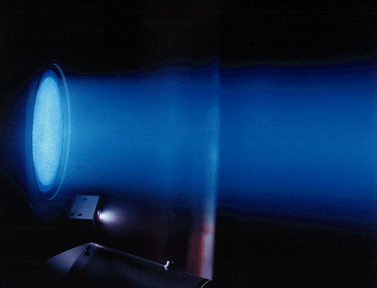|
Incidentally, the emerging jet of ions must be combined with a stream of negative electrons from a separate electron gun. Without this addition, only positive ions would be emitted, and the satellite would quickly become negatively charged by the stripped electrons left behind. The negative charge would then pull back the ions and undo all the work of the ion gun.
Of all the exotic means of propulsion in space, this one is probably closest to practical use. The XIPS ("zips") ion engine developed by the Hughes corporation was tested in the laboratory and then aboard a Russian spacecraft, launched 6 October 1997; it is the one shown on top of this page. An experimental satellite "Deep Space 1", equipped with an ion engine was designed to test the concept and to be the first in NASA's "New Millenium" series.
As with solar sails, solar ion engines are mainly practical in the inner solar system, where ample sunlight is available. For more distant missions it is in principle possible to drive an ion engine by a small onboard nuclear reactor. Such reactors have already flown in space, although they are currently out of favor, in part because a reactor-equipped Russian spacecraft re-entered the atmosphere and crashed into a frozen lake in Canada. For exploring the outer solar system, however, some sort of nuclear power seems essential.
Deep Space 1
"Deep Space 1" was successfully launched 24 October 1998, but the initial 17-hour test of its ion engine on November 10 ended prematurely after 4.5 minutes, which was tentatively blamed on a small short circuit of the accelerating grids, caused by a tiny piece of loose metal. Operators kept trying to restart the engine, hoping to evaporate the offending piece, and apparently that did the job, because some weeks later the engine restarted. The ion rocket has operated satisfactorily after that.
The spacecraft flew by asteroid Braille, passing at a distance of about 26 km and performing observations. It continued to Comet 19P/Borrelly, observing its properties and its interaction with the solar wind. For more, see here.
SMART 1
(Added 16 November 2004) A European satellite demonstrating ion propulsion has reached an orbit around the Moon. SMART-1 ("Small Missions for Advanced Research and Technology -1") was launched aboard an Ariane-5 rocket on September 27, 2003, an 809-lb spacecraft with large solar panels and 181 pounds of xenon fuel, of which 131 have been used so far. After a conventional launch to Earth orbit it started its ion engine to gradually increase its orbital radius, in the process circling Earth 331 times. continued using its engine to approach the Moon and reduce its velocity to where is was captured by a 5-hour orbit around the moon (r about 4550 km). After about a year and a half in that orbit, it was deliberately crashed on the lunar surface.
Dawn 1
(from Sasteroids.htm)
In 2007 NASA launched the "Dawn" mission, which flew past the large asteroid Vesta and then entered an orbit around the largest one, Ceres. Among its distinguishing feature was the use of ion propulsion producing a jet of xenon ions, electrically accelerated using energy from photovoltaic "solar" cells. "Dawn" returned some remarkable images of Ceres, including bright white patches which could perhaps be frozen lakes.
Questions from Users:
Can the plasma that fills space help spaceflight?
Next Stop: #34 Orbits in Space
Th
Timeline
Glossary
Back to the Master List
Author and Curator: Dr. David P. Stern
Mail to Dr.Stern: stargaze("at" symbol)phy6.org .
Last updated: 5-19-2008
|
